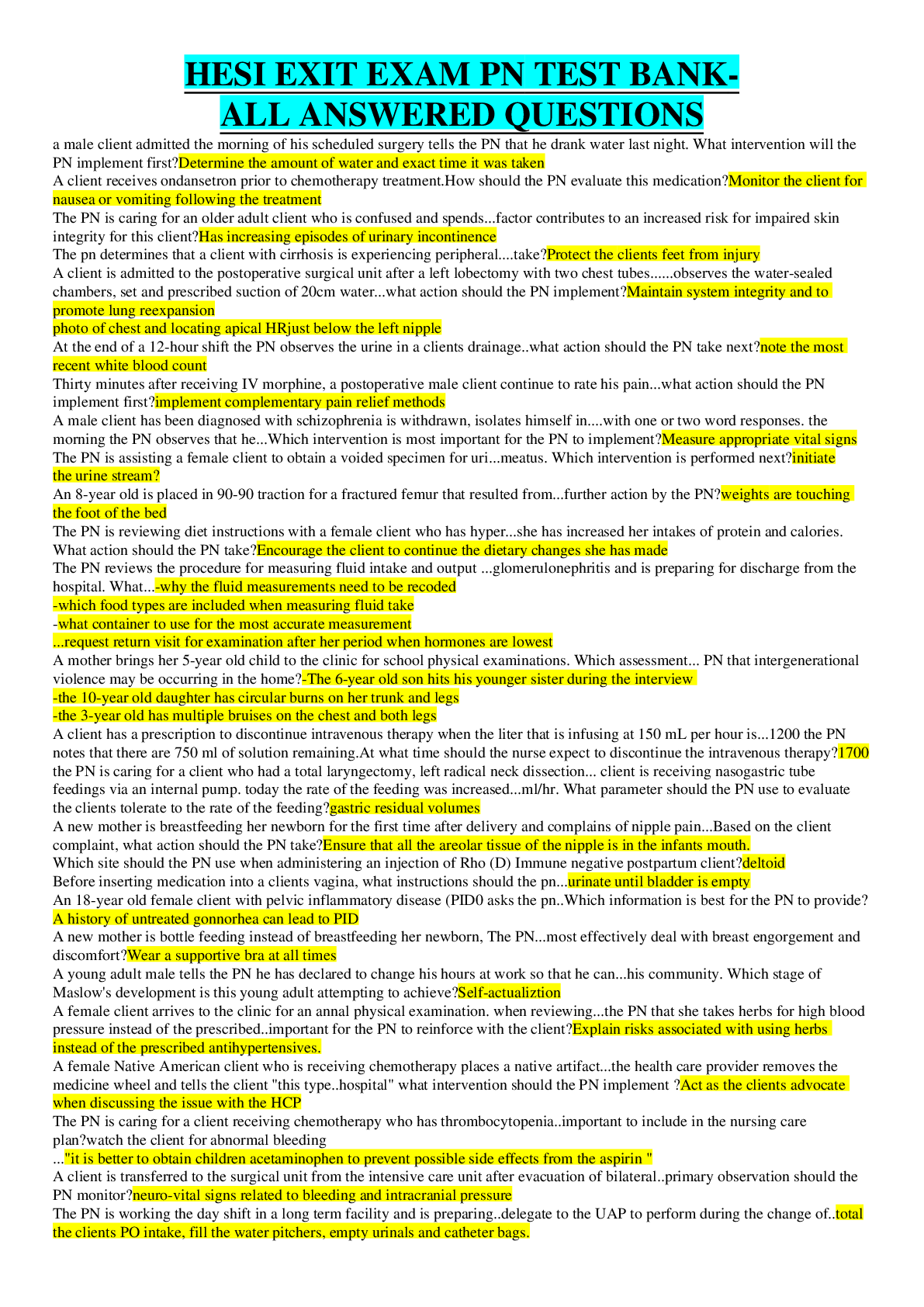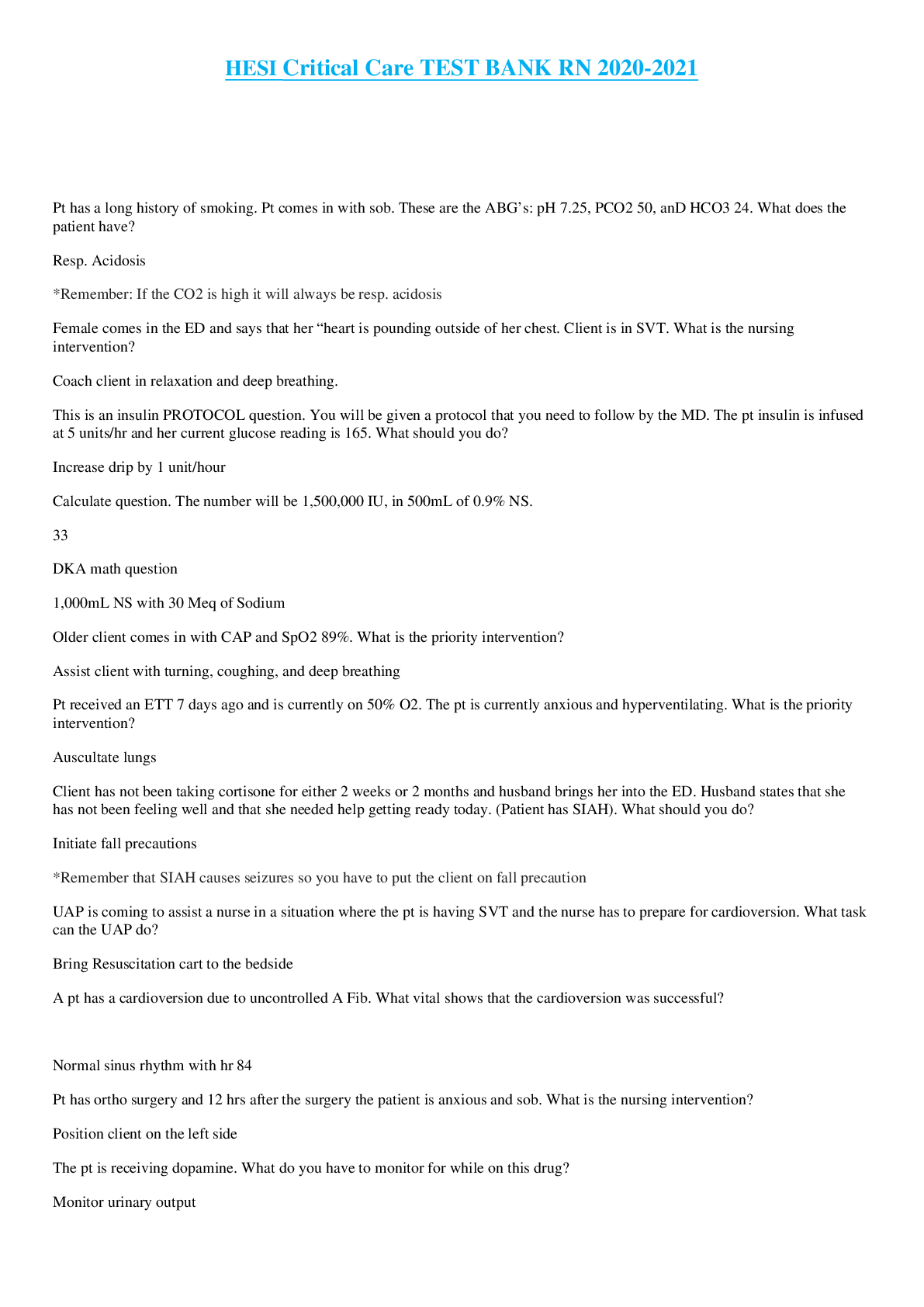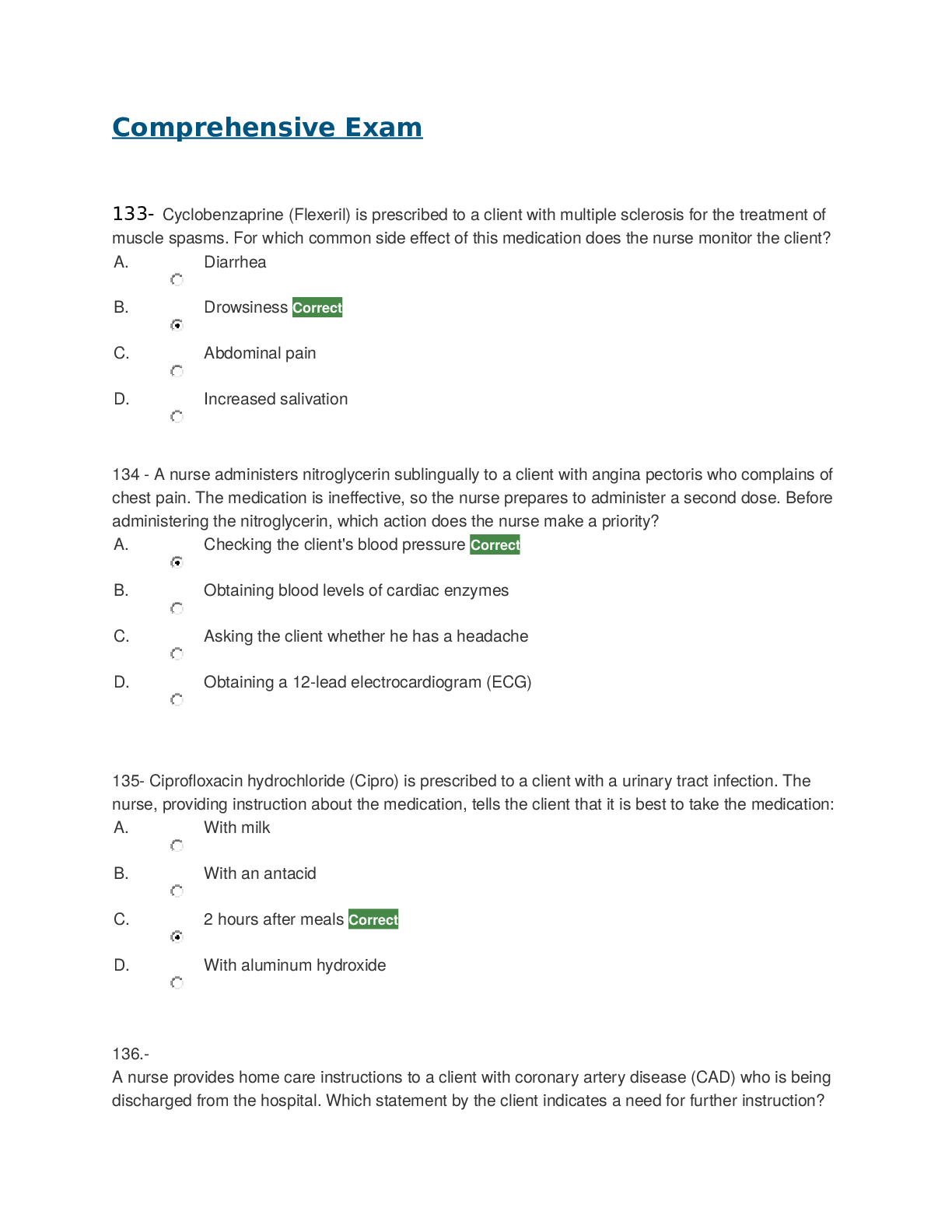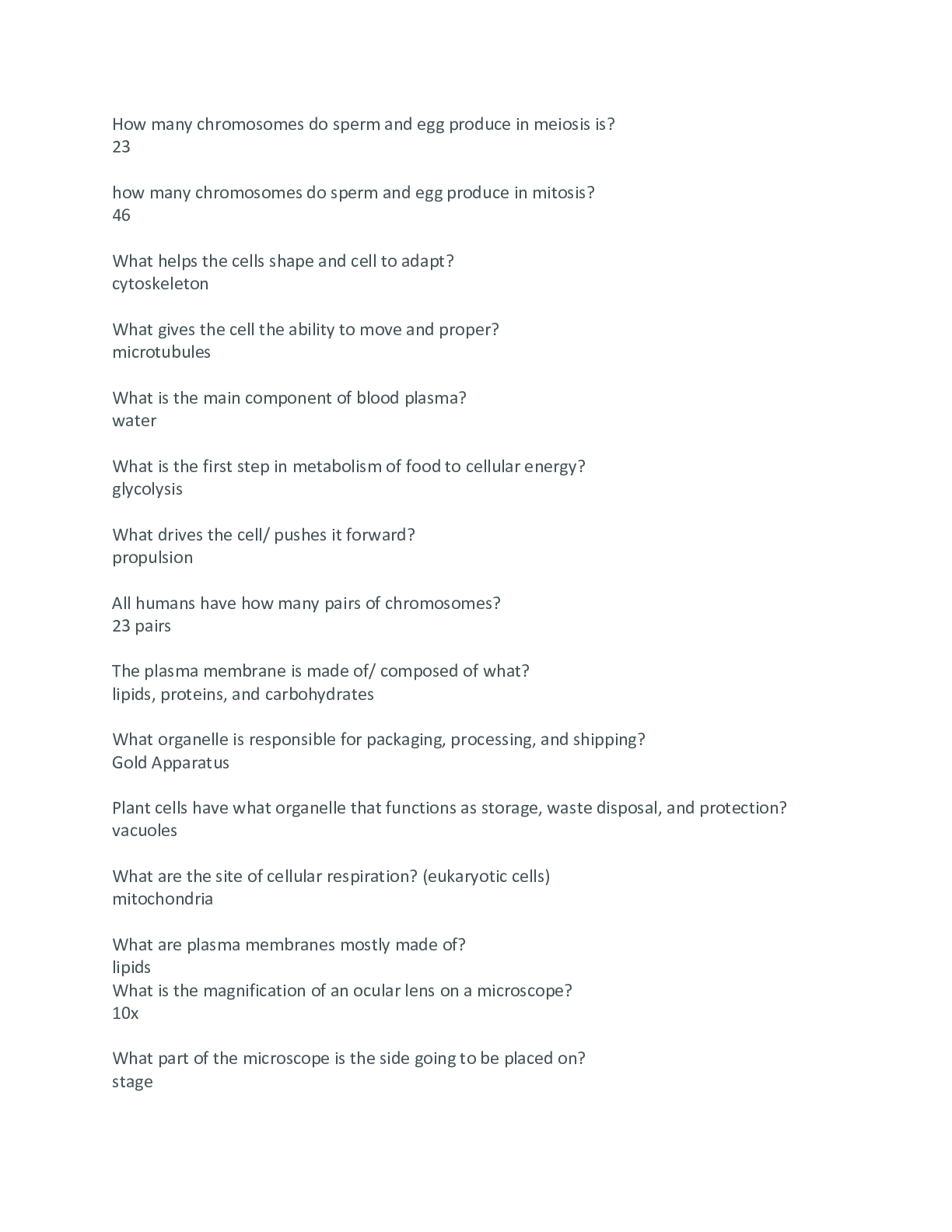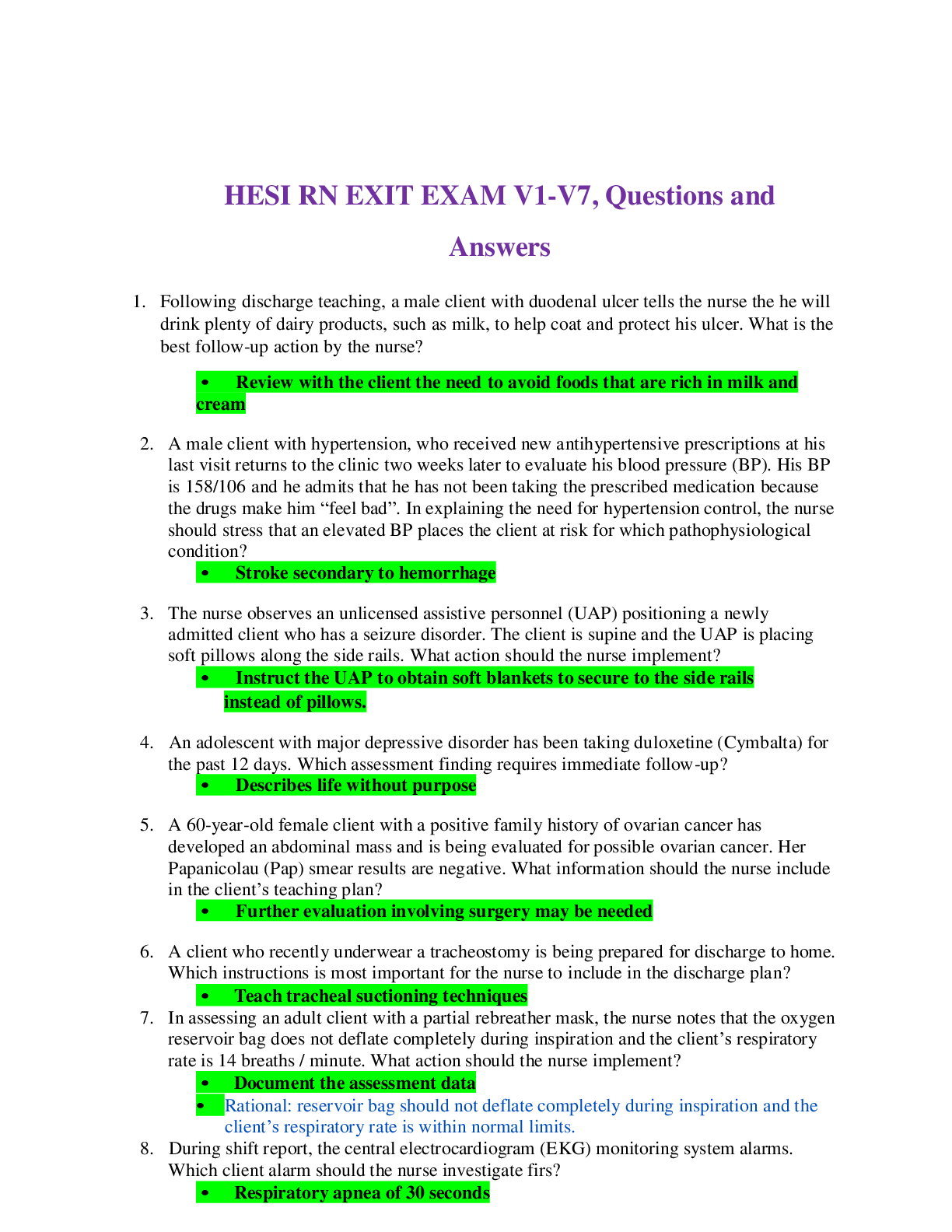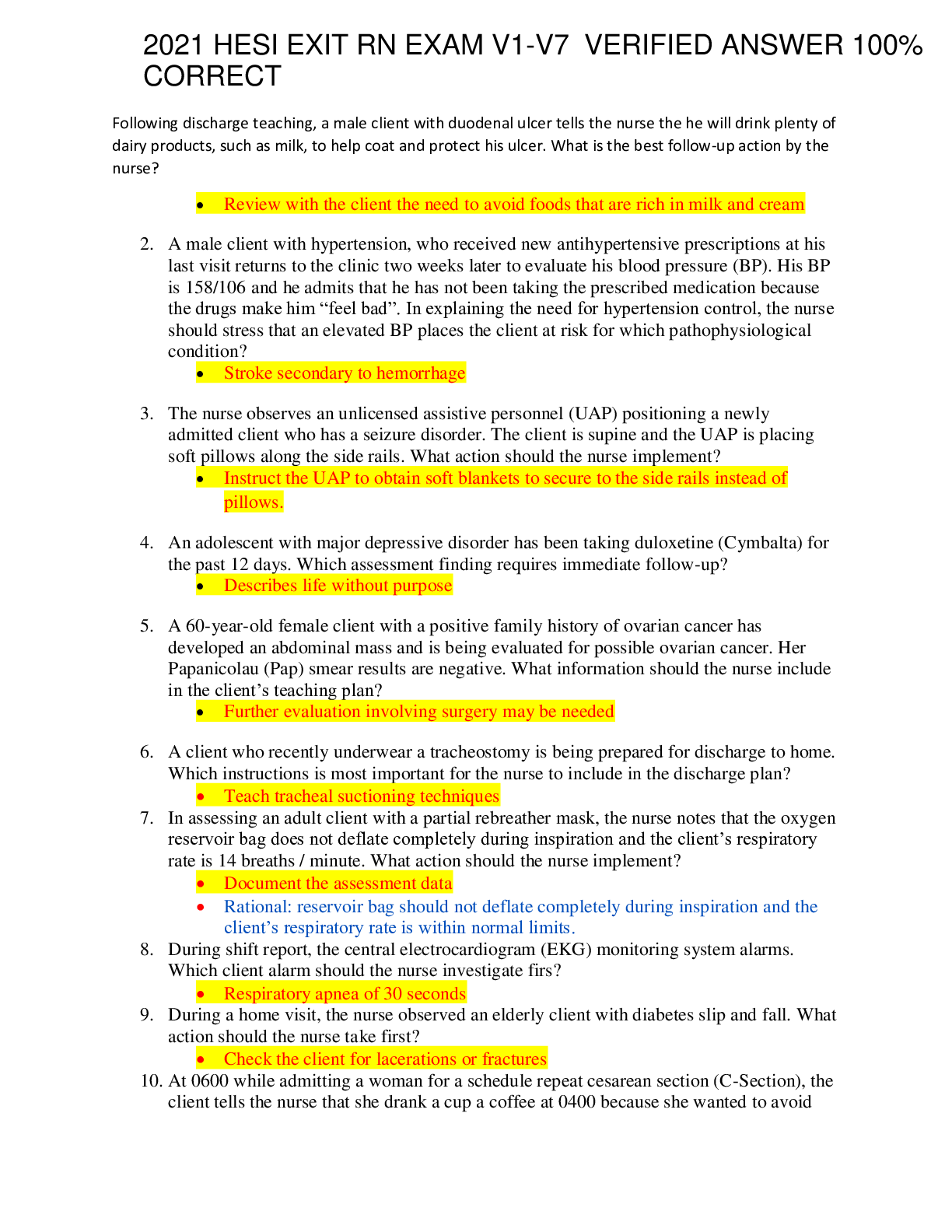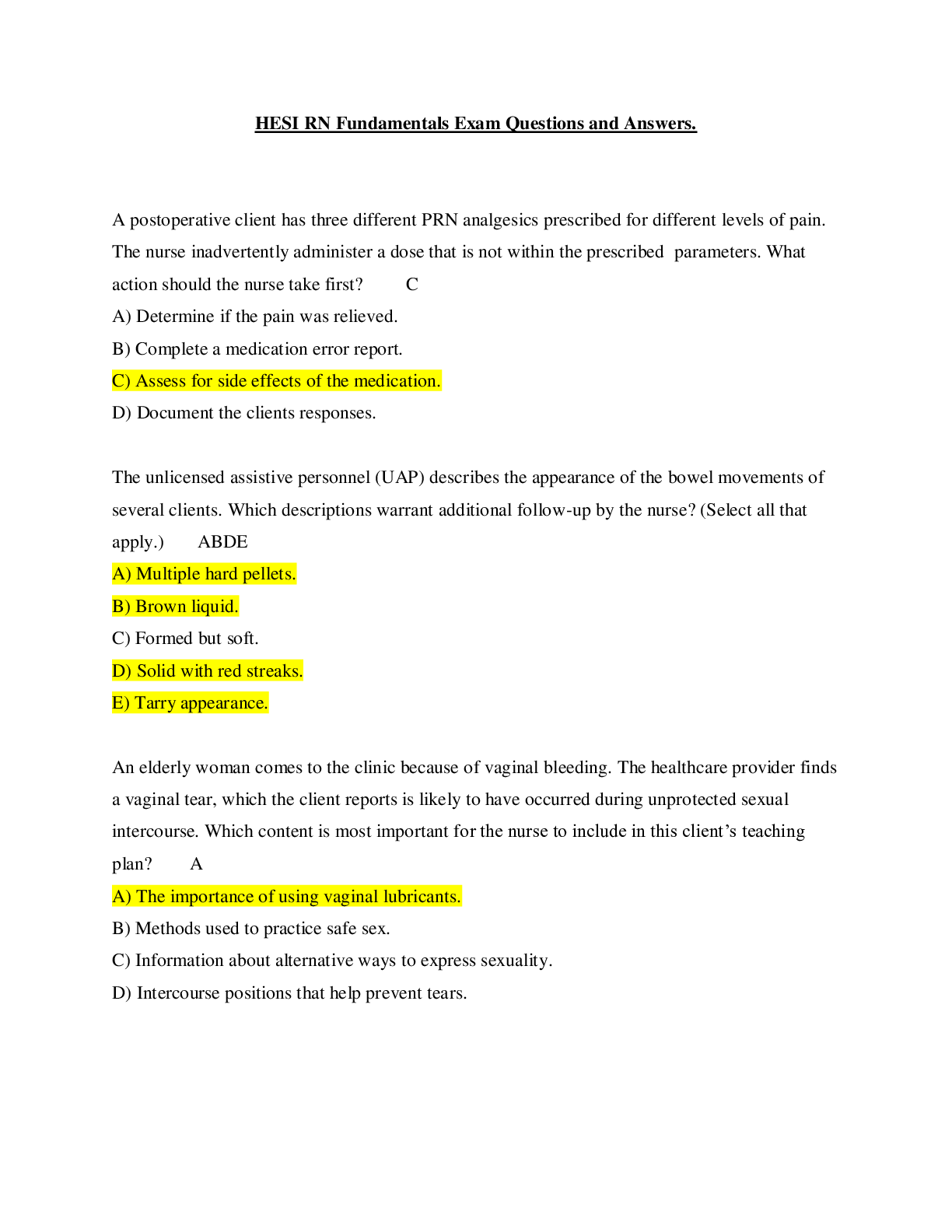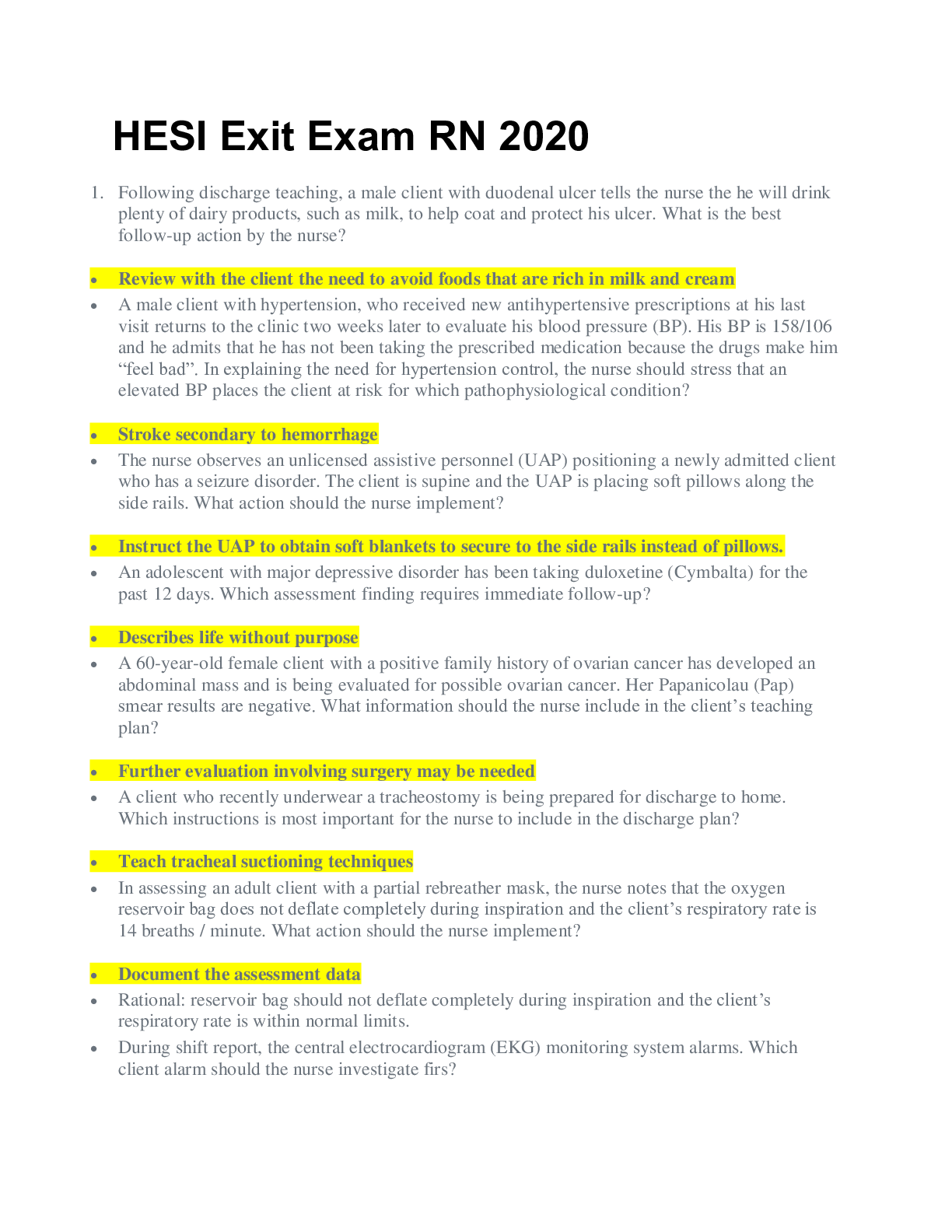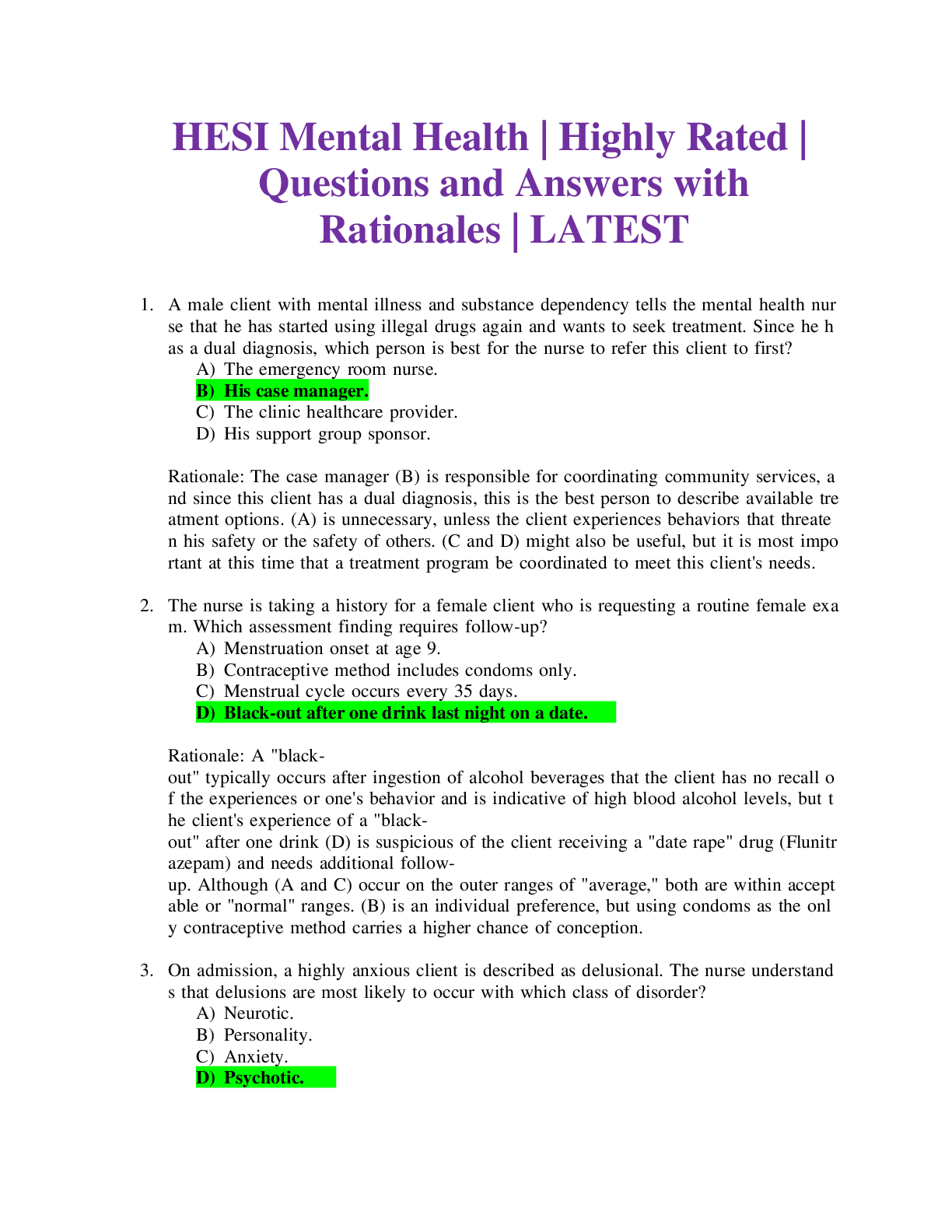Study Guide HESI V5_Complete Latest 2021/2022 A+ Guide.
Document Content and Description Below
Study Guide HESI V5_Complete Latest 2021/2022 A+ Guide. Study Guide HESI V5 Note: The blue highlighted questions came out also on my V2 exam. 1.) Something about a breast cancer patient refusing drug... s: ANS: Go find out why she is refusing 2.) How would you relieve MASTITIS and what is it caused from? Mastitis is an inflammation of the breast, caused by blocked milk ducts/ there is NON-Infective or BACTERIAL infective/ Treatment for mastitis should begin immediately. Your doctor may not immediately be able to distinguish between simple inflammation and a bacterial infection, but will usually treat you as if it is infected. Options include: • Continued breastfeeding and/or expressing to drain the breast • Antibiotics (for example, flucloxacillin or cephalexin) • Anti-inflammatory medication (such as ibuprofen) or analgesia (such as paracetamol) to relieve pain, if necessary • Rest and adequate fluid intake • Heat to breasts (such as hot showers) before a feed and cold after • Varying the feeding position to increase breast drainage 3.) SEPSIS- Related to endotoxins release by bacteria, which cause vascular pooling, diminished venous return, and reduced cardiac output Medical Treatment for SHOCK A. Correct decreased tissue perfusion and restore cardiac output A.1. OXYGENATION & VENTILATION A.2. FLUID RESUSITATION : Rapid infusion of volume-expanding fluids(colloids), whole blood plasma, iso’s such as Ringers Lactate A.3. DRUG THERAPY: Restoration of cardiac function is priority, drugs will be based on effect of shock on preload, afterload, or contractility A.3.a. Drugs that increase preload (blood products, crystalloids)/ decrease preload (morphine, nitrates, diuretics) A.3.b. Drugs that increase afterload ( vasopressors, dopamine)/ decrease afterload ( nitroprusside, ACE-I, ARB) A.3.c. Drugs that decrease contractility (beta blockers, calcium channel blockers)/ increase contractility (digoxin [Lanoxin], dobutamine) A.4. MONITOR: CVP, LOC, ABG’s, VITALS, Skin changes, Fluid status 4.) There will be a question relating to anti-infective meds, and your ANS: is anti-effective meds Anti-effectives Anti-infective are drugs that can either kill an infectious agent or inhibit it from spreading. Anti-infective include antibiotics and antibacterial, antifungals, antivirals and antiproatozoans 5.) Question will state something about the kids want the nurse to force their mom whom is refusing her meds to take them, so the nurse should go in the room and… ANS: is D you will go and in to find out why she don’t want meds and treatment 6) A Girl patient eats a handful of pills… ANS: find out what pills she took 7) A nurse arrives on the scene of an accident and there is a person face down in water but her phone is however many feet away what the nurse would do first ANS: Immobilize neck ASSESS for LOC, check or reassess Airway 8) Question about restraints and where and how you would tie them ANS: bed frame with a quick release knot 9) PAGE 270 HESI: HYDATIDIFORM MOLE- a chorionic villi degenerate into a bunch of clear vesicles in grapelike clusters, this is developmental anomaly and predisposes client to choriocarcinoma Nursing Assessment *Vaginal bleeding in first trimester *Uterus larger than expected for gestational age *Anemia/ excessive N/V, Abdominal cramping, early s/s of preeclampsia Nursing plans and Interventions • Provide preoperative and postoperative D&C care. • *****Instruct patient to prevent pregnancy for 1 year in the (HESI) book, on hesi exam the answer will be 6 months for some reason • Instruct patient to obtain monthly serum hCG levels for 1 year 10) Mouth care for dentures: ANS: Put towel in sink and place dentures on towel then clean 11) You suspect that a Patient is being abused what would you do? ANS: go check it out, as in doing a home visit 12) Question about a patient presenting with decreased BP ANS: Give IV fluids 13) Question relating to stoma care, you will assess and note that the stoma is dusty, this means that there is necrotic tissue; what do you do? ANS: Call surgeon 14) Question about a baby on digoxin and the mother just administered it and then the baby vomits and it will ask what you do about next dose ANS: Hold Digoxin 15) Drag and Drop Question: Patient has adverse reaction to meds: This is the order ANS: 1) STOP IV 2) GET VITALS 3) CALL MD 4) DOCUMENT 5) INITIATE ADVERSE MED 16) Drag and Drop in order question: 1. Place catheter set in between patient 2. Apply sterile gloves, and maintain sterile field 3. Cleanse the Meatus, using that Benodine stuff 4. Lube the catheter tip and then insert Foley Catheter, or any catheter for that matter KNOW SKILLS Gather supplies, explain procedure, maintain a sterile field at all times sterile gloves, prepare your iodine, lube, and syringe for balloon, then move everything in between patients legs, only contaminate one hand and use the other to perform procedure. Watch YOU TUBE if you need a recap 17) Picture Questions: Patient lying in bed only shows lower half from where Jackson-Pratt Drain/tube is at and the bulb syringe is full your ANS: you’re going to drain it The Jackson-Pratt (JP) drain is a special tube that prevents body fluid from collecting near the site of your surgery. The drain pulls this fluid (by suction) into a bulb. The bulb can then be emptied and the fluid inside measured. At first, this fluid is bloody. Then, as your wound heals, the fluid changes to light pink, light yellow, or clear. The drain will stay in place until less than 30 cc (about 2 tablespoons) of fluid can be collected in a 24-hour period. Caring for the JP drain is easy. Depending on how much fluid drains from your surgical site, you will need to empty the bulb every 8 to 12 hours. The bulb should be emptied when it is half full. 18) Picture question/ HOT SPOT- Picture of where to place patches for defibrillation/ got to YOU TUBE 19) Question about a patient has a PCA pump and wants off the pump, you need to read this question carefully, and we believe the ANS: is D relating to food and diet 20) There will be a picture of a central line and the question is going to ask you what you would infuse into a central line… ANS: believe the answer is A but just in case here is a recap on central lines: A central line is indicated for patients who need: parenteral nutrition, chemotherapy or other vesicant or irritating solutions, blood products, antibiotics, IV medications or solutions (when peripheral access is limited), central venous pressure (CVP) monitoring 21) Picture/ video of a mom giving her child insulin she wipes the area, then injects into the deltoid muscle then squeezes ANS: she used the wrong site for injection redirect her to right site. 22) Vasopressors Therapeutic response: is to have increased BP, cardiac output 23) You will listen to heart sounds and it will ask you what you hear ANS: S1, S2, S3 24) S/S of HYPOGLYCEMIA- shakiness, irritability, Nausea, sweating, headache, lethargy, confusion S/S of HYPERGLYCEMIA- polydipsia, polyuria, polyphagia, blurred vision, weakness, weight loss, syncope 25) Glaucoma- a condition characterized by increased intraocular pressure (IOP), is the 2nd leading cause of blindness in the US The question is something about Patient having Pain, ANS: Contact Surgeon * Gradual, painless vision loss, asymptomatic in the early stages * Usually diagnosed during routine visual examination * Early s/s: Increase in IOP ˃22 mm Hg Decreased accommodation or ability to focus *Late s/s: loss of peripheral vision; seeing halos around lights Decreased visual acuity not correctable with eyeglasses Headache or eye pain that can be so severe to cause N/V [acute closed- angle glaucoma] *Treatments and interventions for glaucoma 1) Eye drops are needed for the rest of their life 2) Avoid activities that increase IOP (including constipation) 3) Remove rugs, adjust lighting Page 131 in hesi if you need further review 26) Head Injury- any traumatic damage to the head A. Open head injury- fracture of skull or penetration of the skull by object B. Closed “ “(CHI)-result of blunt trauma (more serious R/T increased ICP in closed vault) C. Increased ICP- MAIN CONCERN in head injury; it is R/T edema, hemorrhage, impaired cerebral auto regulation, & hydrocephalus ASSESSMENT- LOC, vertigo, confusion, delirium, pupils, restlessness, irritability, Changes in vitals, headache, vomiting, seizures, ataxia, abnormal posturing (decerebrate or decorticate), and CSF Nursing Plans and Interventions: 1) MAINTAIN AIRWAY, 2) HOB 30-45˚, 3) Neuro Vitals every 1-2 hrs, temp 4) Avoid activities that increase ICP ******************CONTINUED FULL GUIDE************************************ [Show More]
Last updated: 1 year ago
Preview 1 out of 21 pages
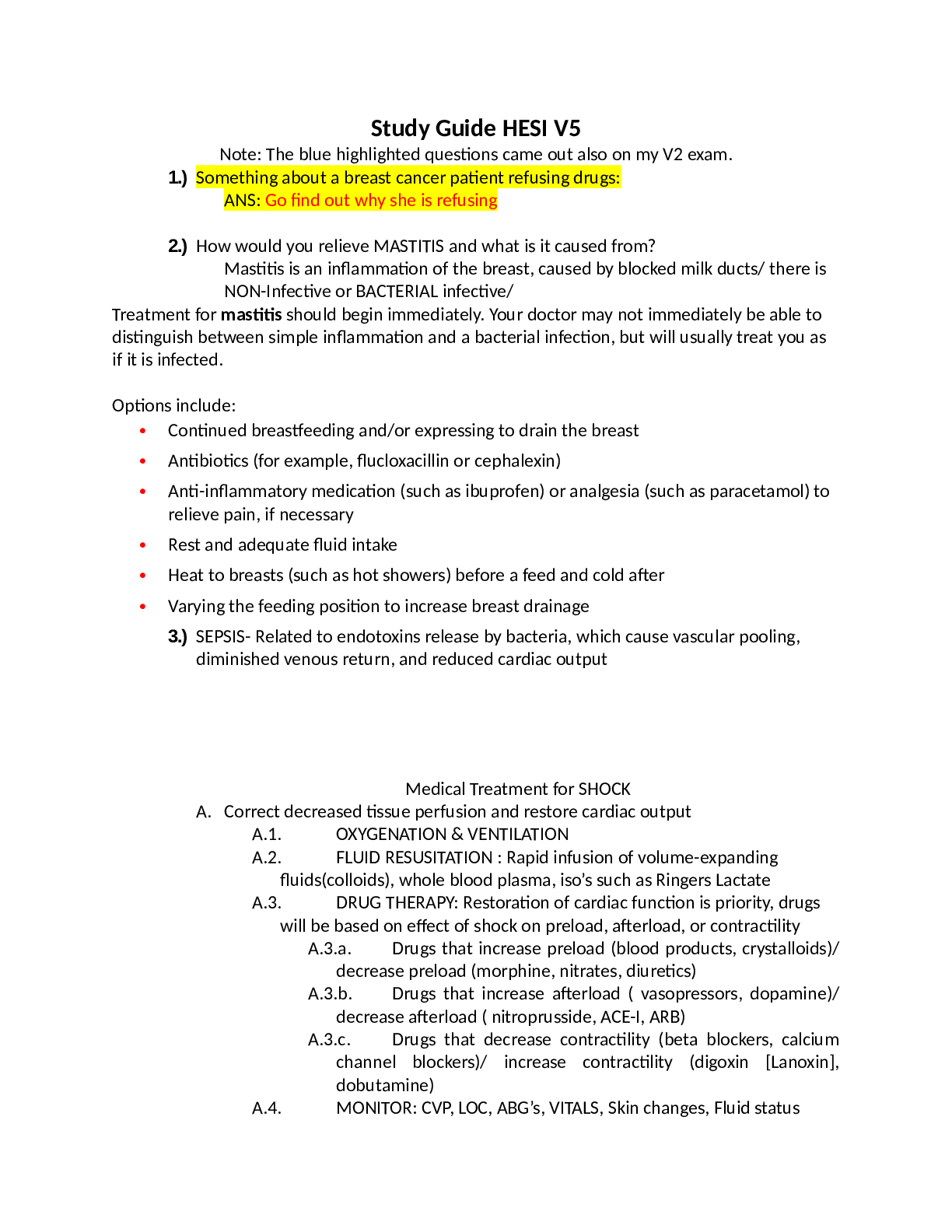
Reviews( 0 )
Document information
Connected school, study & course
About the document
Uploaded On
Sep 05, 2022
Number of pages
21
Written in
Additional information
This document has been written for:
Uploaded
Sep 05, 2022
Downloads
0
Views
78

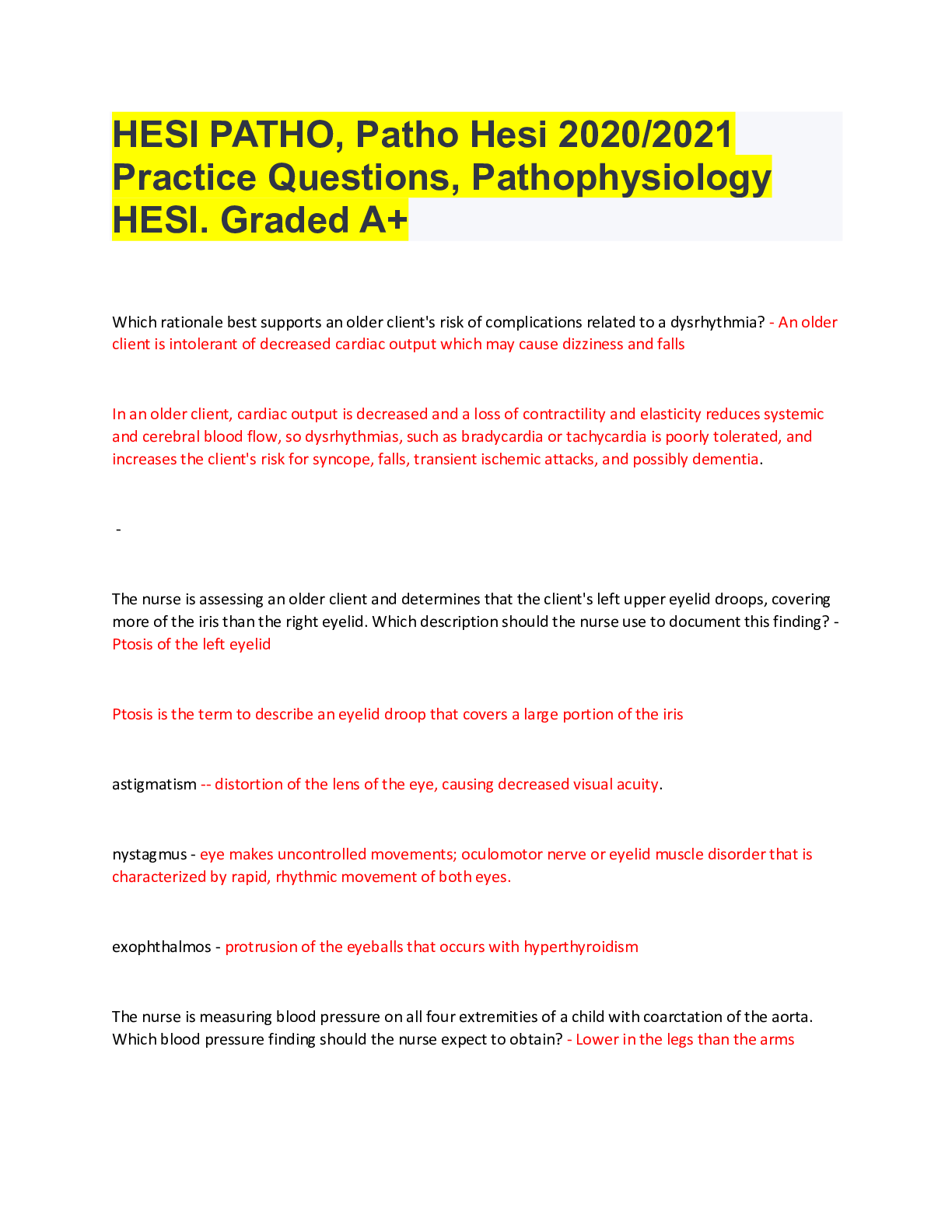
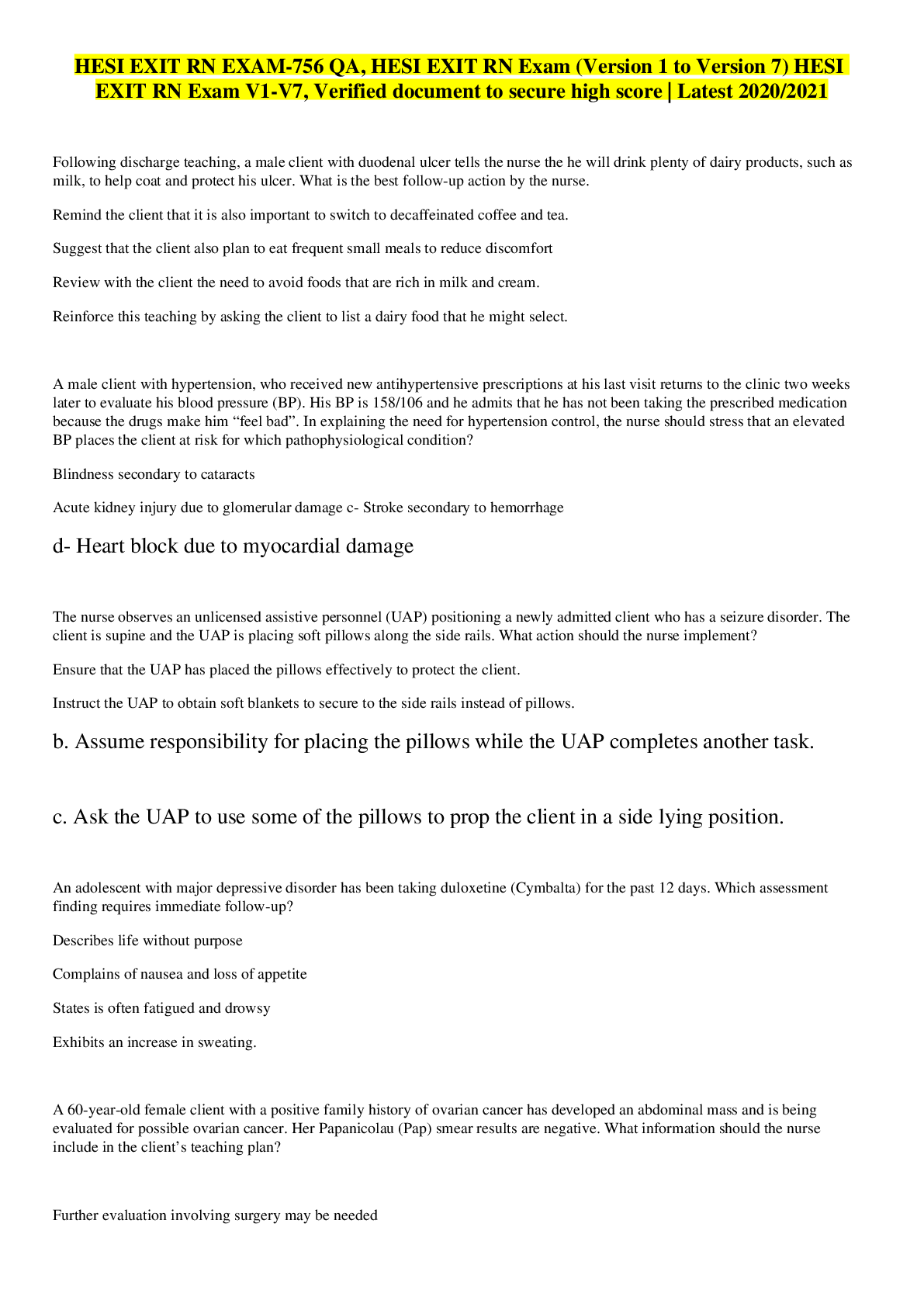
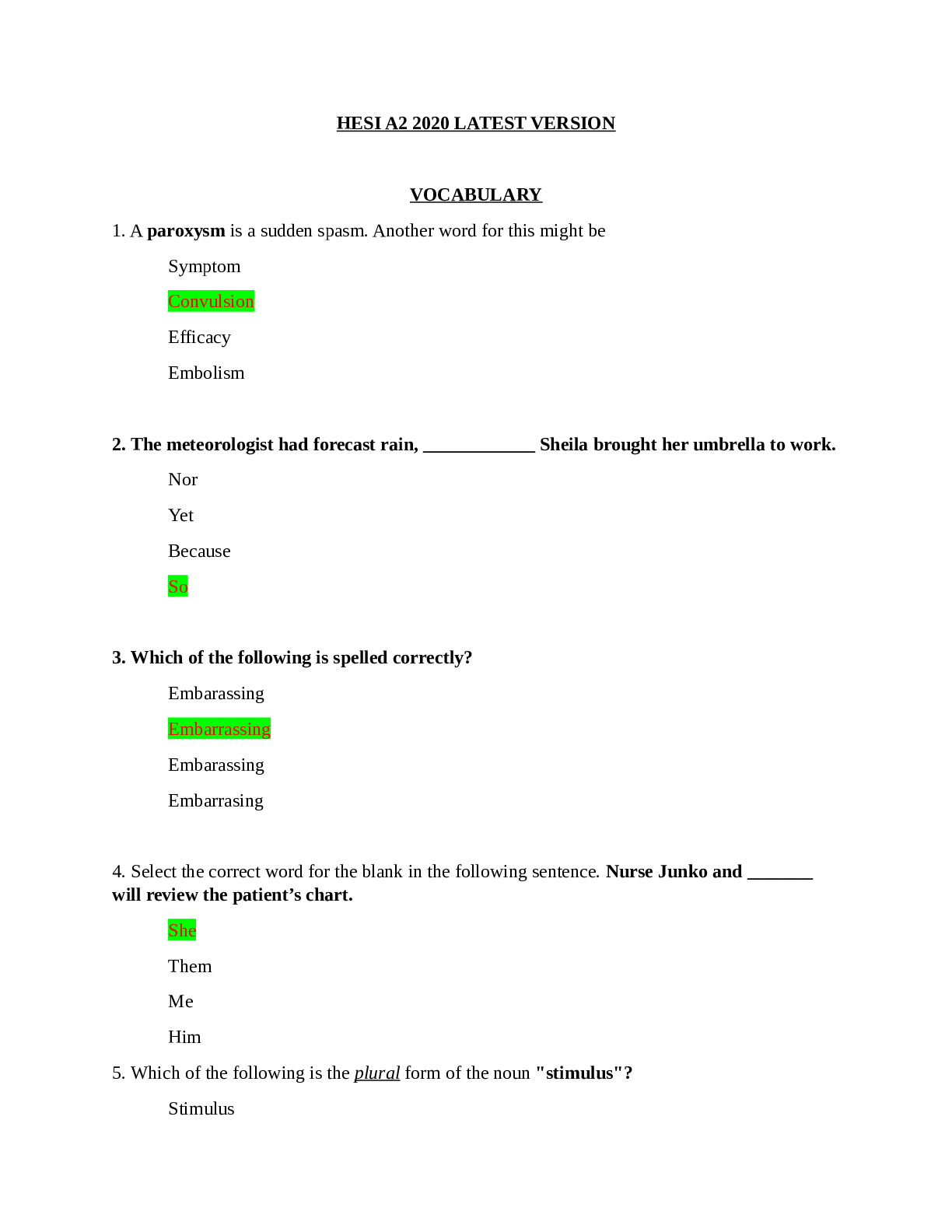
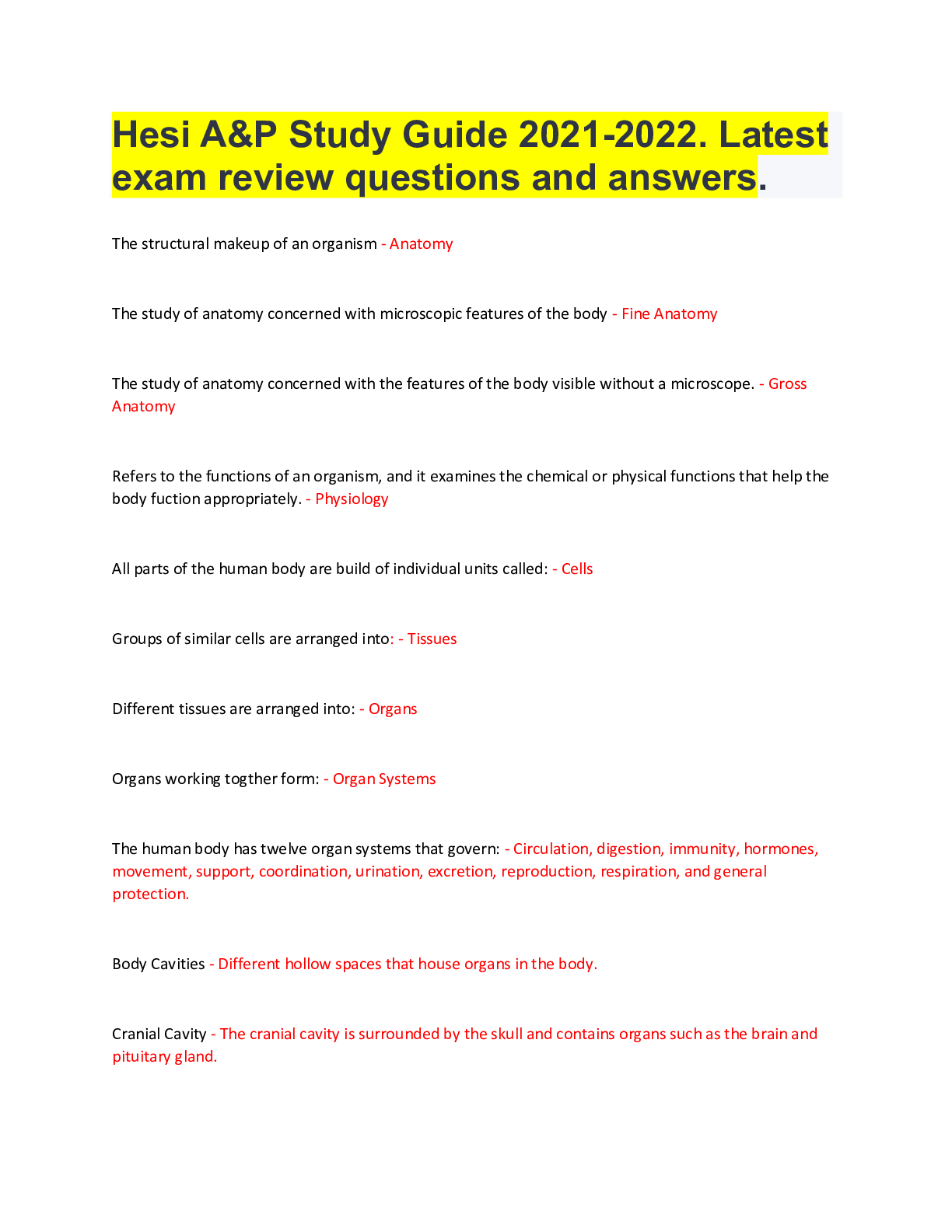
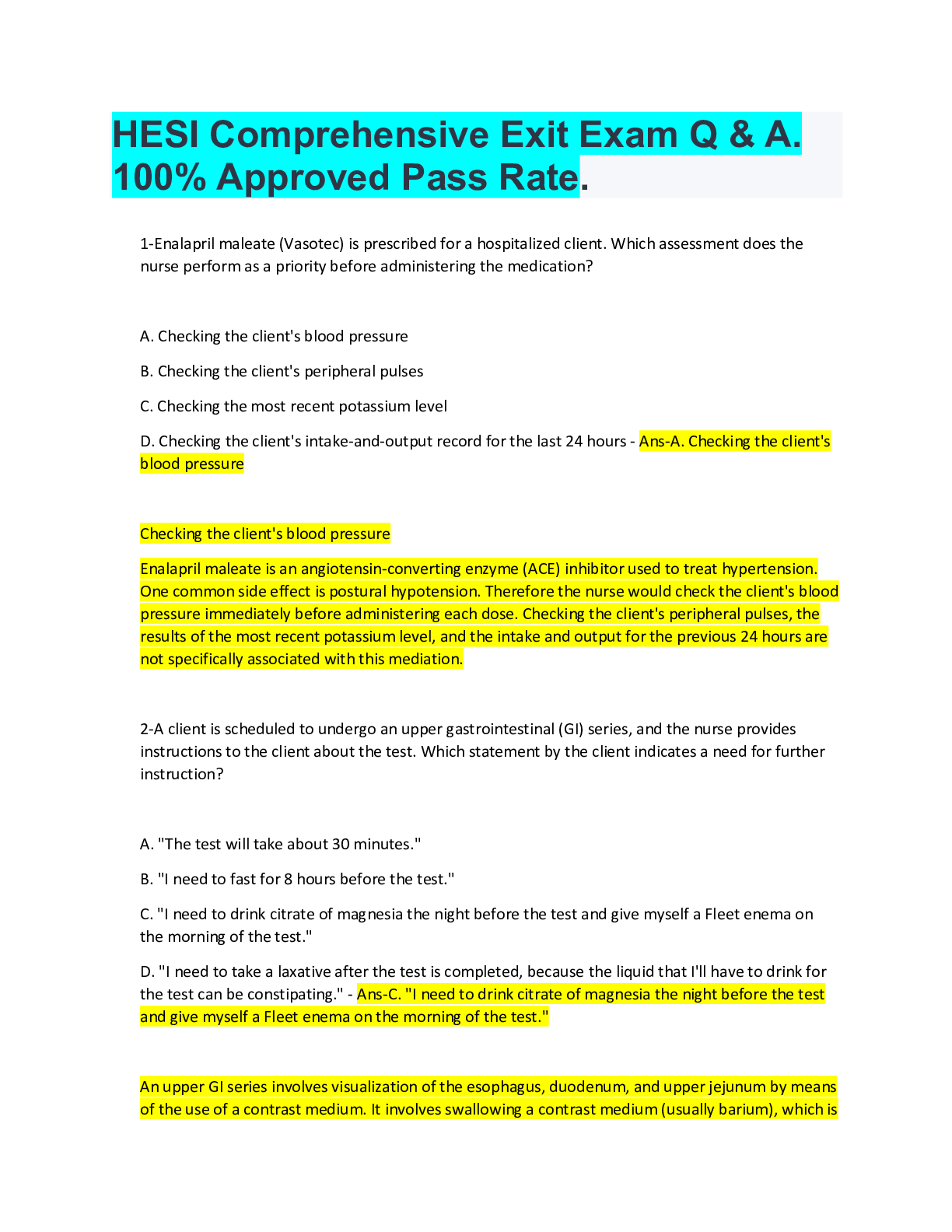
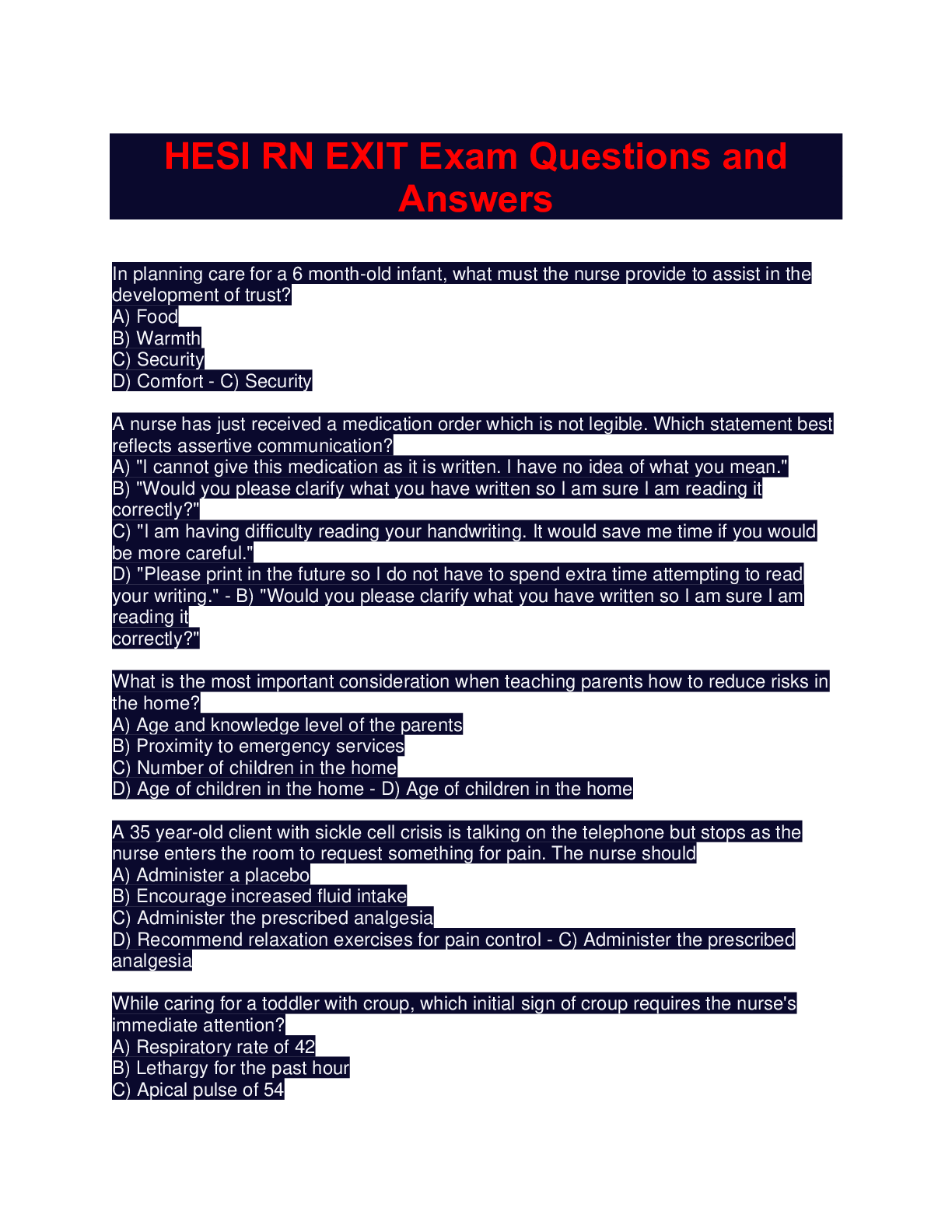
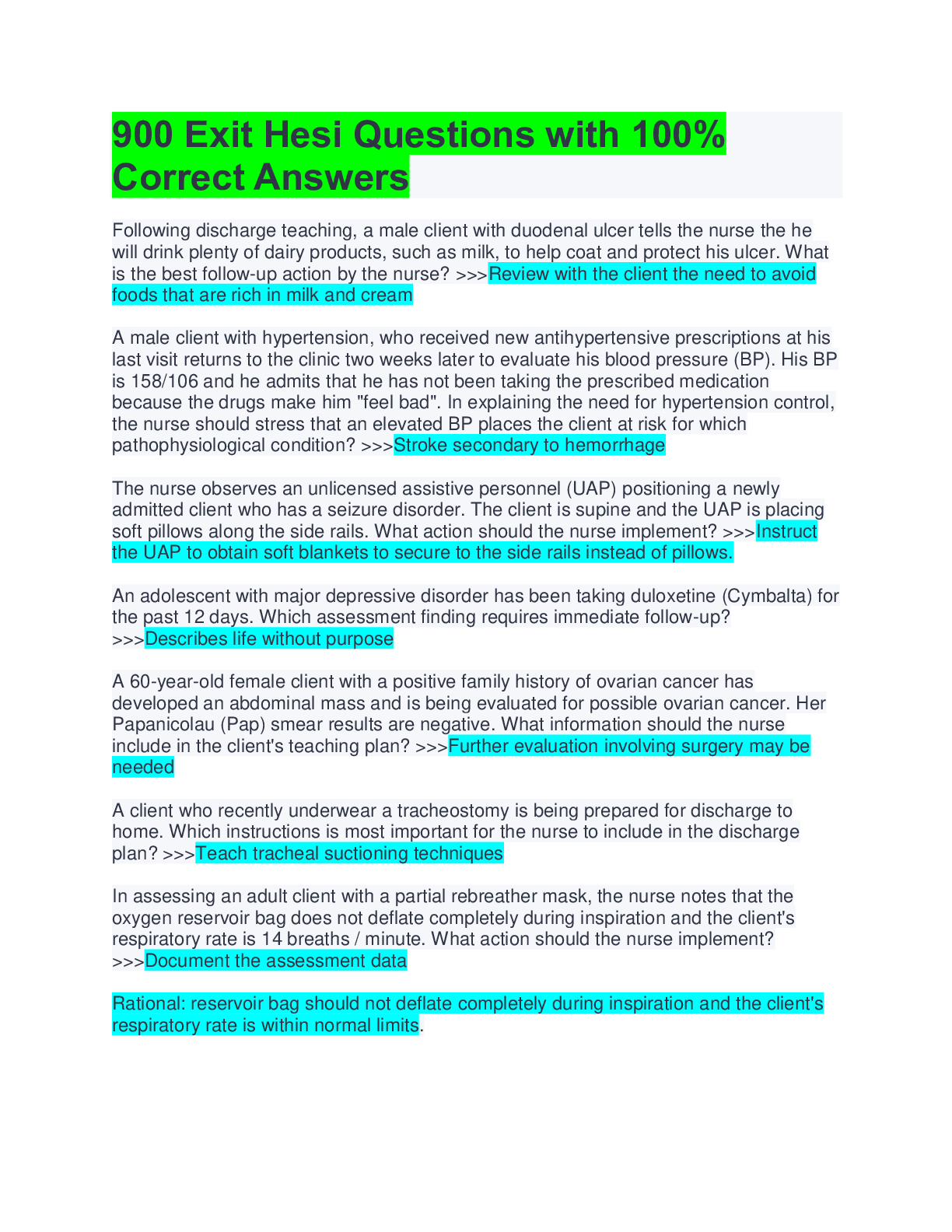

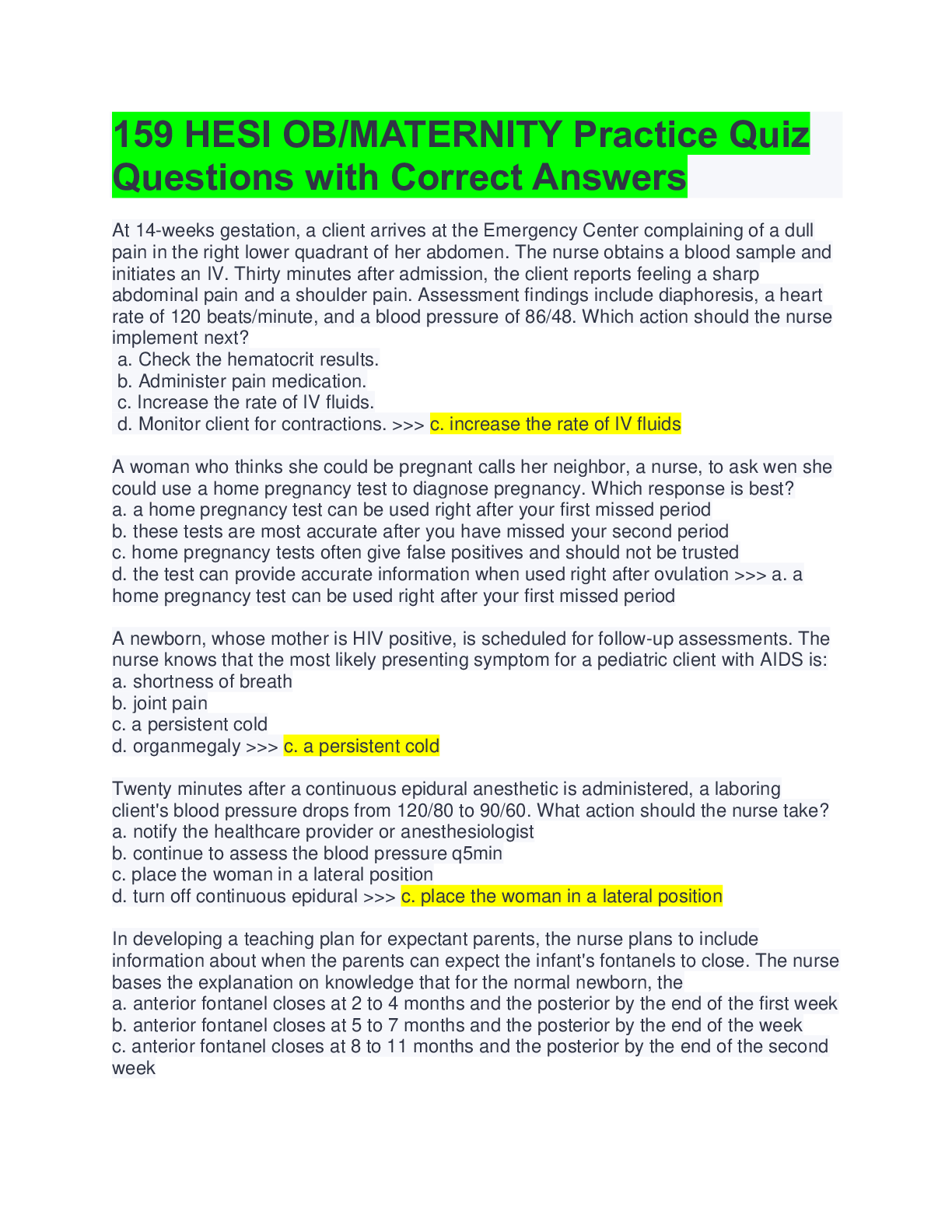
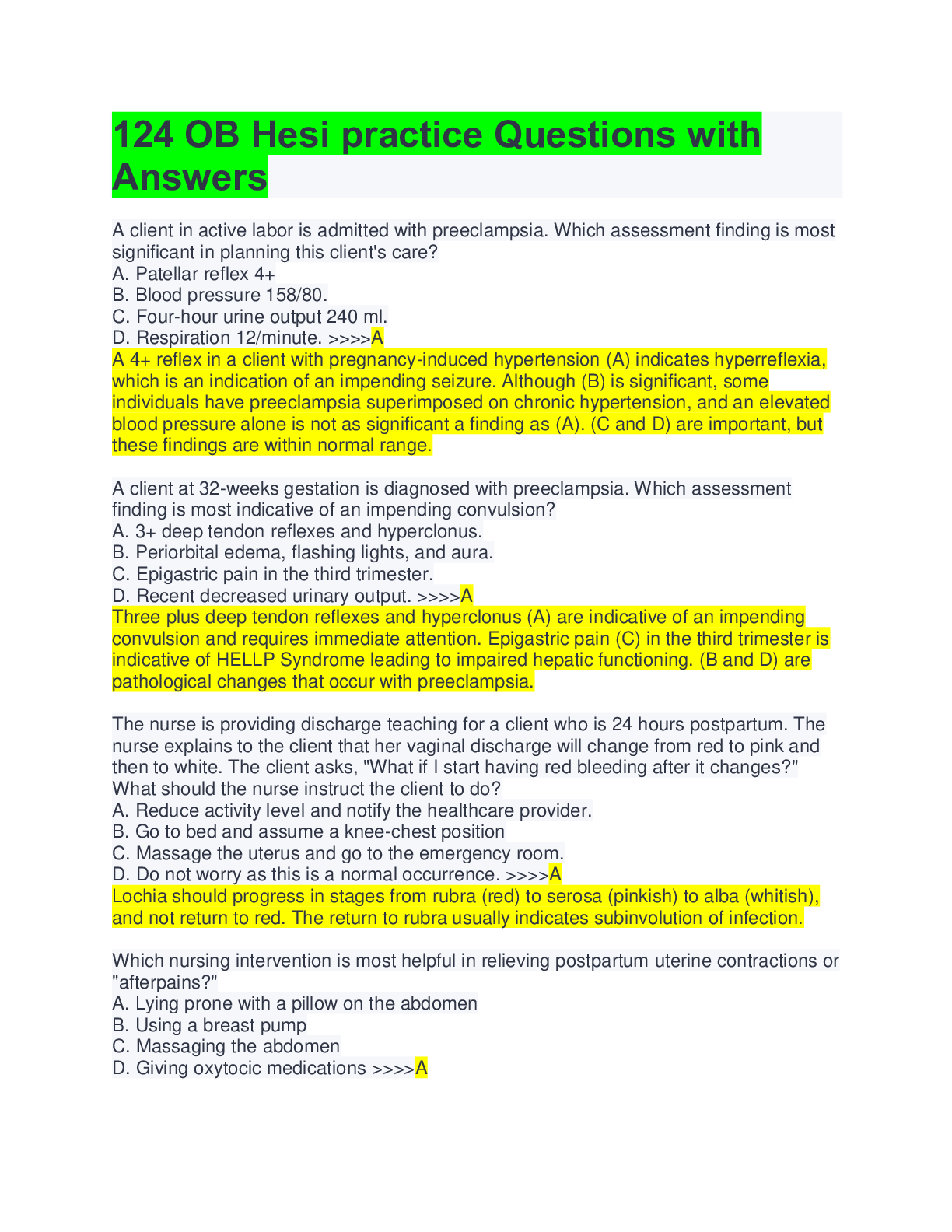
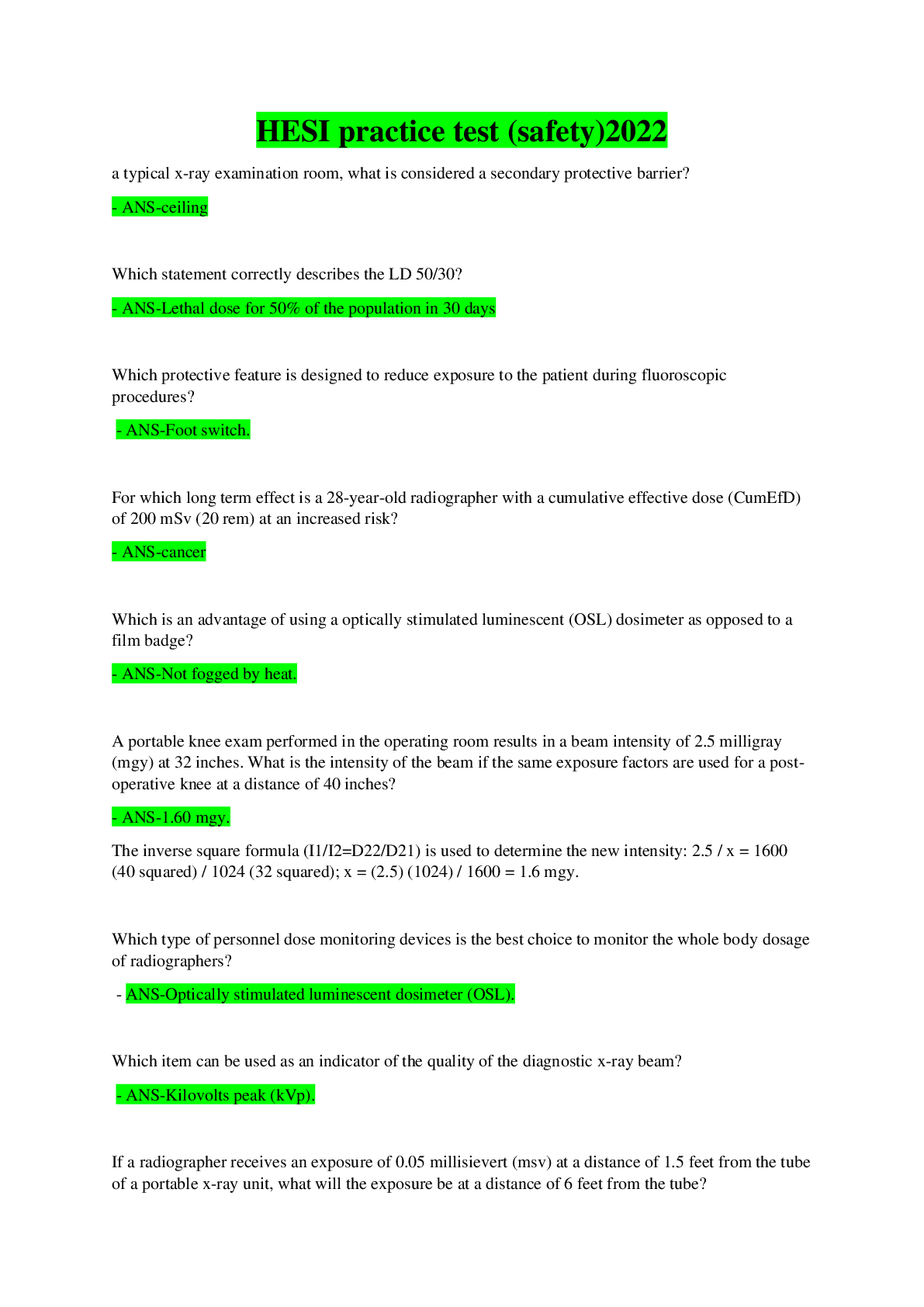
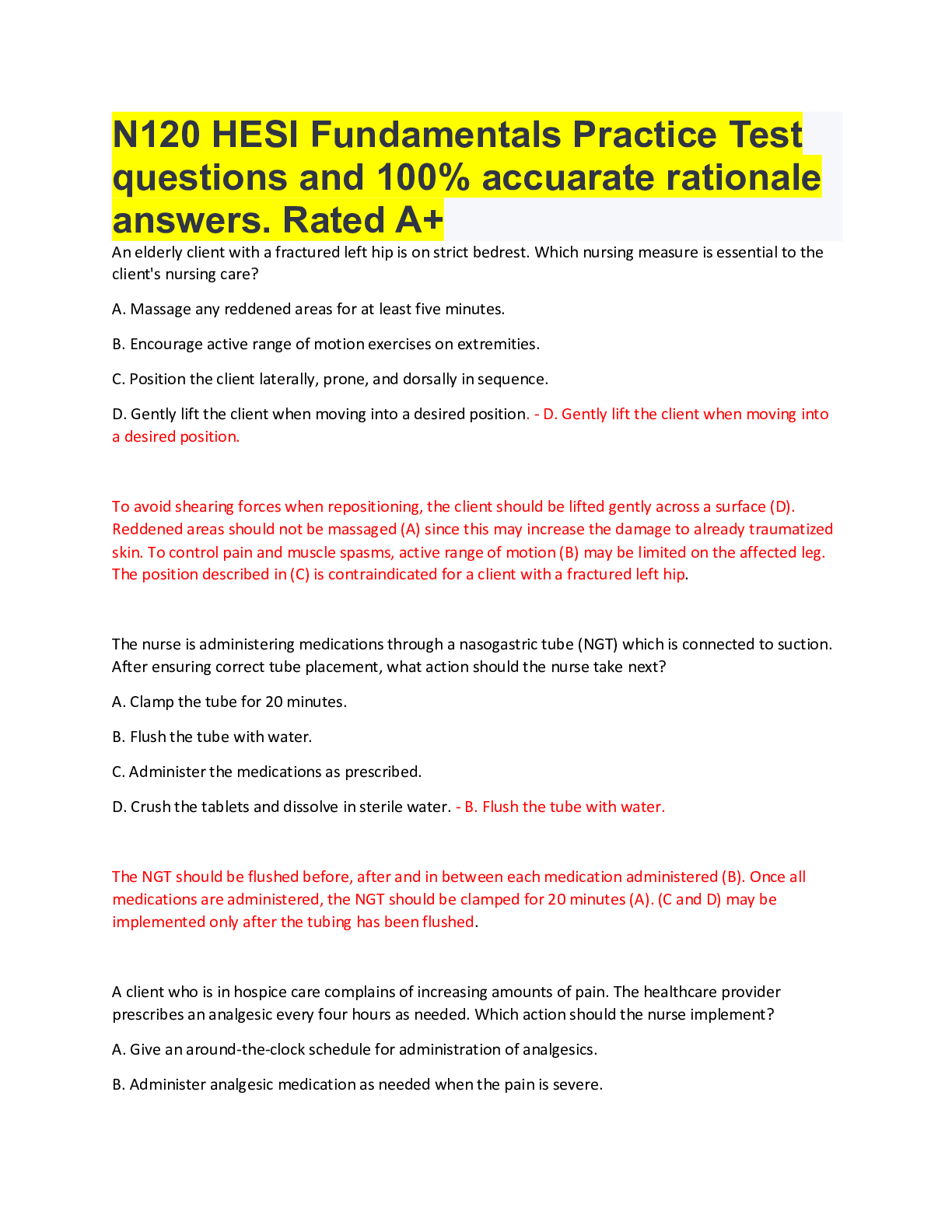
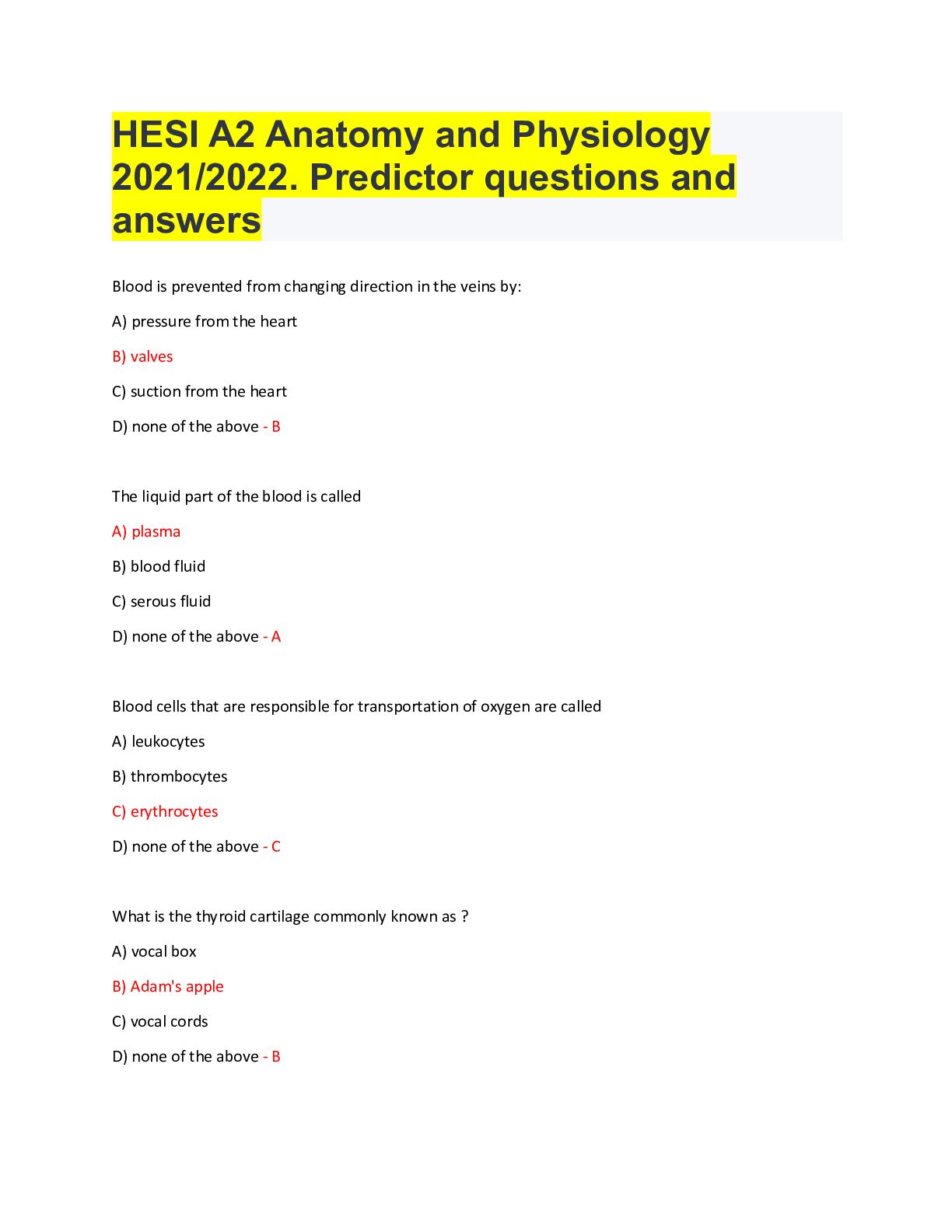

 V1V2.png)
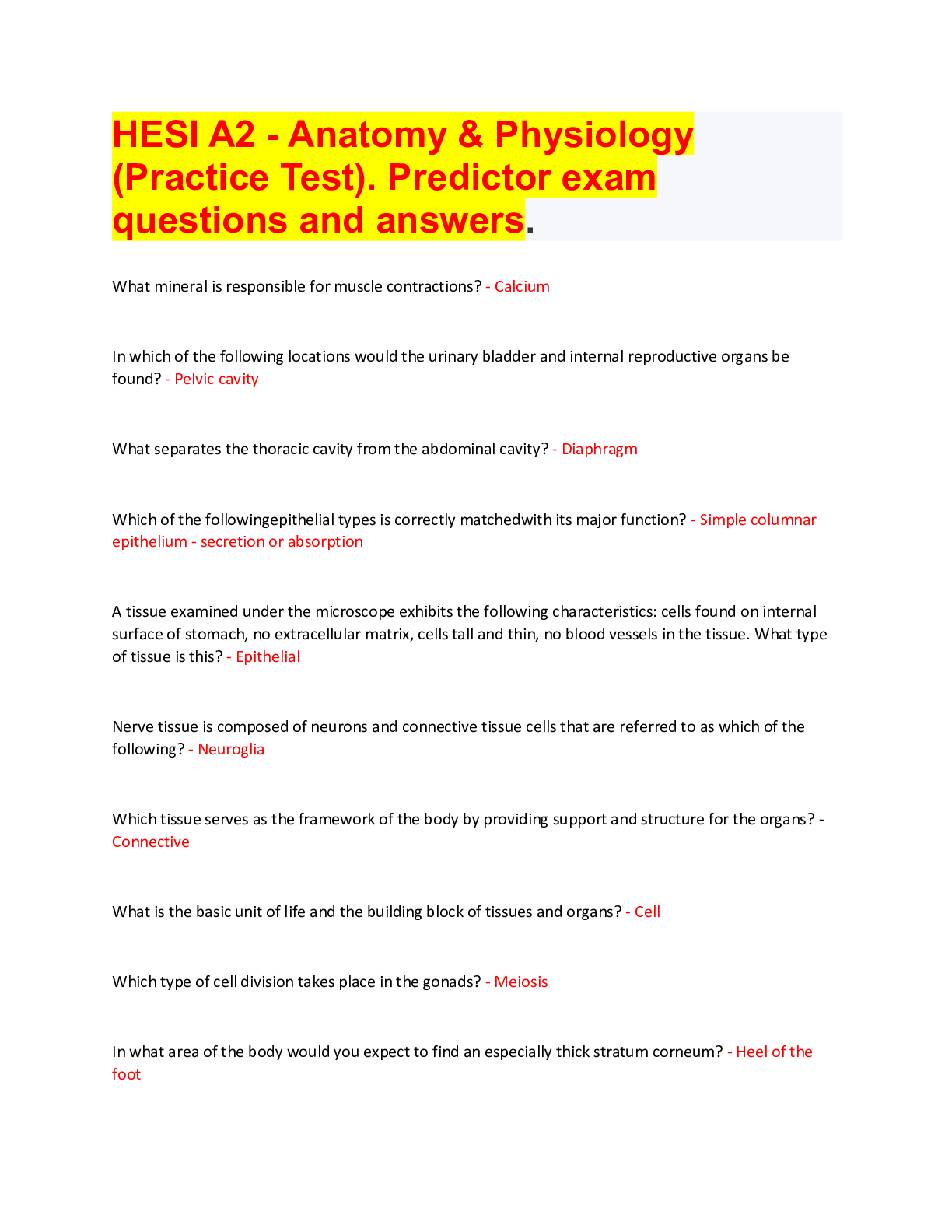






 (1).png)



